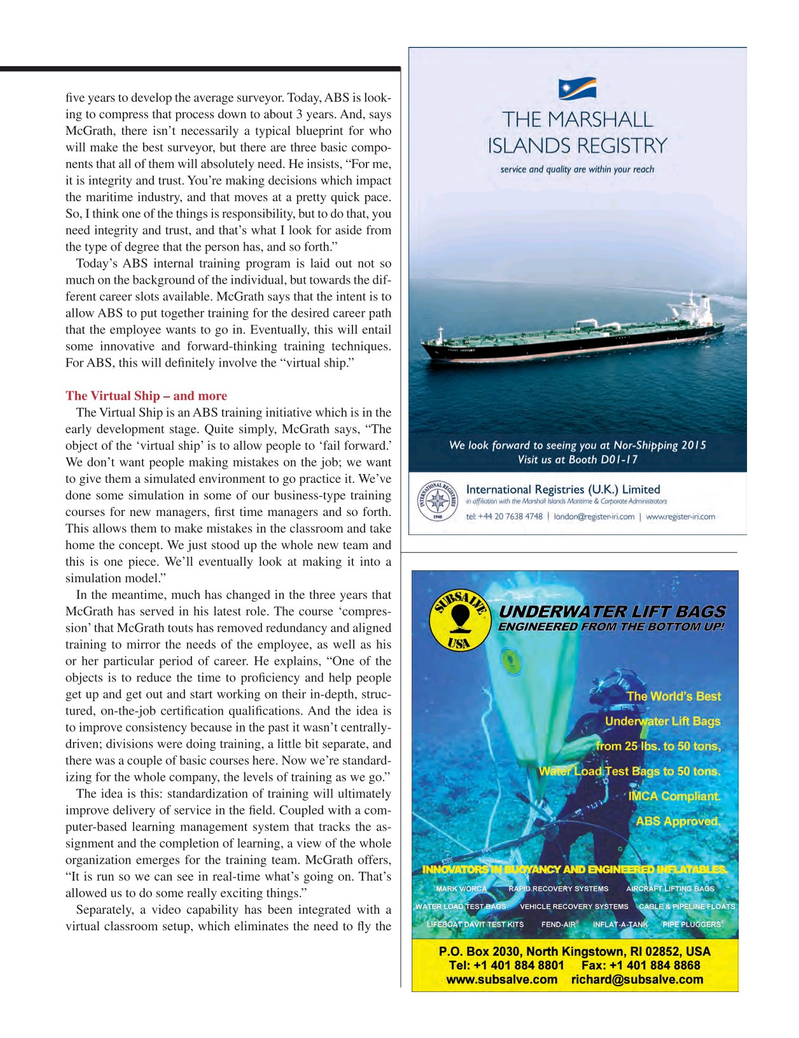
Page 23: of Maritime Logistics Professional Magazine (Q2 2015)
Read this page in Pdf, Flash or Html5 edition of Q2 2015 Maritime Logistics Professional Magazine
? ve years to develop the average surveyor. Today, ABS is look- ing to compress that process down to about 3 years. And, says
McGrath, there isn’t necessarily a typical blueprint for who will make the best surveyor, but there are three basic compo- nents that all of them will absolutely need. He insists, “For me, it is integrity and trust. You’re making decisions which impact the maritime industry, and that moves at a pretty quick pace.
So, I think one of the things is responsibility, but to do that, you need integrity and trust, and that’s what I look for aside from the type of degree that the person has, and so forth.”
Today’s ABS internal training program is laid out not so much on the background of the individual, but towards the dif- ferent career slots available. McGrath says that the intent is to allow ABS to put together training for the desired career path that the employee wants to go in. Eventually, this will entail some innovative and forward-thinking training techniques.
For ABS, this will de? nitely involve the “virtual ship.”
The Virtual Ship – and more
The Virtual Ship is an ABS training initiative which is in the early development stage. Quite simply, McGrath says, “The object of the ‘virtual ship’ is to allow people to ‘fail forward.’
We don’t want people making mistakes on the job; we want to give them a simulated environment to go practice it. We’ve done some simulation in some of our business-type training courses for new managers, ? rst time managers and so forth.
This allows them to make mistakes in the classroom and take home the concept. We just stood up the whole new team and this is one piece. We’ll eventually look at making it into a simulation model.”
In the meantime, much has changed in the three years that
McGrath has served in his latest role. The course ‘compres- sion’ that McGrath touts has removed redundancy and aligned training to mirror the needs of the employee, as well as his or her particular period of career. He explains, “One of the objects is to reduce the time to pro? ciency and help people get up and get out and start working on their in-depth, struc- tured, on-the-job certi? cation quali? cations. And the idea is to improve consistency because in the past it wasn’t centrally- driven; divisions were doing training, a little bit separate, and there was a couple of basic courses here. Now we’re standard- izing for the whole company, the levels of training as we go.”
The idea is this: standardization of training will ultimately improve delivery of service in the ? eld. Coupled with a com- puter-based learning management system that tracks the as- signment and the completion of learning, a view of the whole organization emerges for the training team. McGrath offers, “It is run so we can see in real-time what’s going on. That’s allowed us to do some really exciting things.”
Separately, a video capability has been integrated with a virtual classroom setup, which eliminates the need to ? y the

 22
22

 24
24
